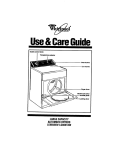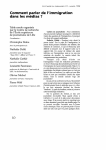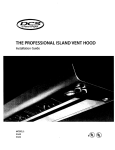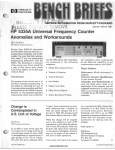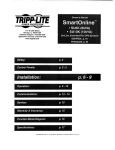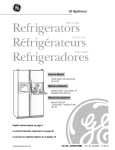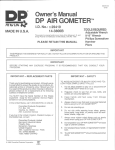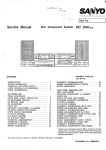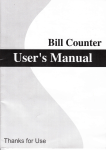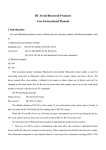Download phillips_pm 3323 - Micro Precision Calibration
Transcript
. ~~llJrl;~ " PM'3310N& ..- ~ PM . 3323 With compliments Helmut Singer Elektronik www.helmut-singer.de [email protected] fon +49 241 155 315 fax +49 241 152 066 Feldchen 16-24 D-52070 Aachen Germany appIies to both channeis, Simuhaneously, and SynchronouSIy.It ofters a full 2 ns resolution for &ach channel, tor repetitive signals and single events! And random sampling permits the use of higher time base speeds for repetitive signals, so that the full 300 MHz of the instrument can be used and stored. Each channei is also provided with a dual, fast peak-detector which permits the capture of events down to 3 ns, even when slow time base speeds are used. This is not onIy useful to catch short glitch-type signals over Ionger time windows, It also allows the instrument to accurately digltize and display high frequency signals which are modulated in amplitude by a lower frequency, wlthout aliasing. For the slowest 01 signals, a roll mode is provided. The roll mode can be triggered, if desired, 10stop at any significant signal detail. Trlggerlng and Delay Capabilities The PM 3323 Cf PM 3320A can be triggered from a choice of internal and external signal sources.Pre-trigger 01 up to one lull screen is JX)Ssible, not only in the direct acquisition modes, txJt also at the higher time base speeds, thanks to the instrumenfs random sampling technique. Extensive post-trigger recording with delays of up to 1000 screen lengths permits analysis 01 small signal details out cf lang and complex signals. In addition, the REST ART lunction, which enables the user to quickly 'zoom in' on a point of interest, make analysis fast and simple and provide a better alternative to the traditional Delayed Sweep arrangement. Trigger level can be checked in the CRT cisplay lor fast setup, for all selected trigger sources, whether internaI, or external.ln addition to normal trigger delay, the delay can also be used to give an intemaJ time delay after an external event. Both models also otter excellent TV bigger capabillties. (See also PM 8917.\ ExtensiveAcqulsitionand Display Functlons The PM 3323 and PM 3320A have extensive acquisition, calculation and display functions to capture exactly the signals of interest and quickly extract Ihe information arId measurements required. 80th models otter an absolute minimax mode ('envelope' mode) Ihat creates a cumulatlve record of signal amplitudes over the measuring period. Also availabie are stop on difference and save on difterence modes. These allow signals outside a predetermined band to be captured. after which acquisition either stops (stop on difference) or continues after saving the waveform in a register (save on difterence). In both cases the signals are time and date stamped 10 help reiste intermittent faults to possible external causes. In combination with the other acqui- Inputsand SignalAcquisition The PM 3323 arid PM 3320A have the power Storage and versatility to cover a wide range of appjicaSignals trom each channel can be stored in tions',Two signal inputs ~e provided, each with each of,four 4k memories. This allows tor easy a ~01C8 of 1 Mn, or .san Input impedance. '!"he companson of waveforms, or the display of refbullt-ln 50n terminations are protected agalnst erences. A uniqtle, multipie-single-shot mode damage through overtoads by a combination ofWithallows tor quick and autornatic storage of up to compliments.doc sottw,are and thermal protection. tour dual-channel acquisitions whlch occur rapd ,CaJibrat~ ~ltage ~ftset of up t? 1000 x each succession. All waveforms are kept with all releInput sensltivlty permits the full utillZation of the vant acquisition parameters, such as sensitivity. instrument's 10 bit ~ertlcal resolution even when time base. and delay settings at the moment of examlnlng small signals present on large DC recordlng. Areal-time clod( provides automatic offsets. Even if the magnitude of this DC oftset is 'time stamps'. Full cornpatibility with GPIB/IEEEunknown the PM 3323 or PM 3320A can mak,e 488* and RS-232C enables almost unlimited the compensation ,automatically USlng thelr recording of waveform data on extemal devices. AUTQ-OFFSET facll~. -:0 enab~ a~urate measurements on nOtsy signals, whlch IS often ~ sition modes such as pre- and post-triggering, the case high ba~dth low level signals, Display and Soft Keys ~ averaging mode IS Indi~nsable. The averThe PM 3323 and PM 3320A have a large 10 offseI arid restart, the PM 3323 and PM 3320A otter exceptional versatility in capturing and analyzing exactly the sign~1of interest. A complete measurement center In one unit. aglng mode reduces the nolSe: drastically, enabllng a clean,~I~ay 10be achleved even ,at the hlghest sensltivi~es. Further, the PM 3323 s fast 500 MS/s sampilng rate (250 MS/s on PM 3320A) x 12 cm CRT screen. The center 8 x 10 cm ares is exclusively used for waveforms. The edges of the screen the show acquisltlon para~ of liv. .innal. nr ",f nrAoli ,e". ~;~":~c PMß320A.&'BM,ß323 ,. ,. ~ID~ ~ .,~~ , ~ --- -- --- "-"- r Cir.;;.: forms. Thls clear separation of signal traCesand parameters eases Interpretation of results. All softkey displays are to the right of the display and adjacent to the softkeys. A separate numeric keypad allows dlrect input of pertinent data such as offset and delay. Operationand UserFrlendliness All main functions are directly accessible to the user, without the need to leam soft-key menus. This also eliminates the time consuming need to back up through various levels ot menus to change instrument settings.And Phillps 'Greenbutton' Autoset provides tor even taster set-ups by automatically determining the optimum acquisition parameters tor any input signal. This is a great help in flndlng and viewing unknown signals.Once captured, wavetorms are immediately dispiayed, and without Interference from text or menus. All texts are dispiayed aJongthe screen edges, with only channel ident/tication (A or B) dlspiayed wlth the relevant trace. The PM 3323 and PM 3320A even show a waming when aliasing due to undersarnpling isdetected! The logical front panel layout tollows the traditional concepts of clearly grouping Input channeis, time base tunctions and trigger tunctlons. This Iogical approach makes the use of this advanced DSO possible righl from the start. SetUp Memories Both models have user-programmable setup feature allows even greater aase ot use, providing automation without a computer. This ensures repeatability of tests and their results.Up to tully 250 user-detined instrument setups can be stored tor measurements of user-specific interest. These instrument setups can also be linked together to form sequences ot lest steps, or can be recaJled at random. Versatile MeasurementFunctions Once a signal has been acquired, a tull range ot measurement and calculation functions to extract exactly the information needed trom the signal are availab1e. Measurements ot voltage and time dlfferences between the cursors positioned on a single wavetorm are possible. In addition cornparative measurementsto be made between !wo wavetorms recorded on channel A and channel B, or between separate waveforms stored in any ot the instruments tour memory registers.Not only absolute and relative time and VOItage measurements are possible,but also phase measurements. In each case, all that's necessary is to position the cursors on the desired part of the signal or signals concemed, make a simple menu selection ot the required measurement, and the numeric result is immediatety dlspiayed on-screen. To enhance and quicken speciflc application measurements the PM 3323 and PM 3320A also otter tull automatic cursor posltioning. In this mode the cursors are automatically positloned with respect to user deflned reterence levels. The choice ot refer- encelevelsare: MIN PEAK the most negative signal value measured MAX PEAK the most positive signal value meas- ured ABS VOlT an absolute voltage level set by the user PROB LOW the voltage level thaI corresponds with the Iower flat part of a pulse PROB HIGH the voltage level thaI corresponds with the upper flat part of a pulse The !Wo PROB reference levels are derlved from the amplitude histogram cf the signal being measured. This ellminates the influence of overshoot, preshoot, and ringing on time measurements derived from these amplitude levels. These reference levels define the 0 % and 100 % vaJues values tor cursor positioning. The cursors can then be automatically placed at any value between -50 % and + 150 % relative to these reference levels. Cursors can also be used as 'Smart-Start cursors'. When the cursors are pIaced over any signal detail of interest, the activation of 'Restart', automatically reestablishes proper delay and sampling speed to acquire that detail with maximum resolution. Advanced Signal Processing Modes Constructlon The sturdy construction provides for a varlety ot operating configurations. At just under 18 kg, it can easily be carried trom one Iocation to another, and the carrying handle doubles as an adjustable stand. Scopecart PM 8991/04 ofters further rnobility. In addition, a radtmountable version tor use in standard 19 inch racks is also available. ,.7?18PM3323aridPM332OA~ /8. ~ ~ GWnf8r. 8ecaUN« fIe 10x 12an. ~ sJzesm fuU8 x 10an dsdcSJ8dIr*» .. . ~ 8xt /8 intefferingMlhthecfSJWajl8d~ The PM 3323 and PM 3320A offer more than signal measurements alone. A wide range of signal-processing modes allow you to expiore more deeply into your acquired signals. and perform calculations that reveal hidden data and relationships.The basic arithmetic tunctions of add, subtract. multiply and divide are supplemented by signal differentiation and integration. as weil as amplitude histograms. the appiication of digital filters and an optional FFT facility tor signal representation and analysis in the frequency domain. System Use The interface option on both models otters JulI GPIB/IEEE-488 and RS 232C capabilities. All controls can be set or read. Waveform data can be taken trom any of the tour memories. or be sent back to the scope ,tor example when Ioading a template for the 'stop on difference ' mode. All 250 user defined setup memories can be set by the controller, as weil as called by the controller. This drastically reduces bus traffic and significantly speeds automatic testing applications. Hard Copy Each model is equipped with an analog output to drive an analog XY recorder. The operator can seiect any waveforrn in any memory to be drawn by the recorder. Instruments equipped with the interface option provlde direct 0U1putto plotters or printers. A digital plot or pt'int --. -. any waveforrnis possible.aIong with aiphanumeric data pertinentto that waveforrn. 2. RestaIt fastzoom.;,«I"" äW. AI ftl8t's n-.Iy is 10kJc.- .. QI-. 8IOImd .. .,.. of , ~ , ttIeRes8rtk8y.A ~ ~ is ".. . . ~ ~ ,. #JeluI ~. ,. » "., Ire .. of PM 331b~& PM 3323. Specifications Technical Specifications Uniess stated aß specifications refer 10 both PM 3323 and PM 3320A. CRT Philips 180 mm rectangulartube with 16 kV aa:eleration potential and P31 phosphor (GH). 100 mm x 120 mm useful screen area. 80 mm x 100 mm tor traces. Readout: Three separate areas reserved for front panel setting information, register parame- 12.A tJIfw.x.".of Ihe mIftI fadIity -inI8g/'8te.." ".,... Ihe inIegra/of ltIe signal ~ /he ters on softkeymenus ~ A convwWnt displsy Ior UM in 'energy' Gratfcule: InternaJwith % indications. Illumina~forBDmp/e. tion continuously variable Autoset Sets display. text, verticaJmode, horizontal mOde and trigger coupling in a predefined position. Other parameters depending on signaJ so that available signals-are COrrectly recorded and displayed. Signal Acqulsitlon Sampllng Type: Realtime: PM 3323 100 ns/div...360s/div. PM 3320A 200 ns/div...360s/div. Equivalent time: PM 3323 5 ns/div...SOns/div. PM3320A5 ns/dIv...100ns/div. 13;Fuirt..,.ptoces8ngglv... ~t6t1»nsion ~-MaximumSampIe Rate: shotsburledin noise.77IMe~ unmce ~ Real time: PM 3323 500 MS/s. ~ NlatcanbB 'awraged'/f noiseexIs'-... PM 3320A 250 MSis. once~ 8IIda~ cannotbe useQ'. ~ IhePM EquivaJent time: 10 GS/s. Externeiclock: 50 kS/s. Vertical Resolution: 10 bits or 0.1% 01 tu" scale Voltage resolution: 50 I1V Maximum Horizontal Resolution Single channel (single shot) PM 3323 100 ns/div...500 jJ,s/div: 512 sampies/ acquisition: 1 ms/div...360s/div: 4096 sampies/ acquisition PM 3320A 200 ns/div...500 jJ,s/div: 512~ acquisition; 1 ms/div...360s/div: 4096 samples/ 14. The opfonal FFT hIJCt/on wi#I Nl8dBlNB Witw»wIng (18ctanguIar. H8mWIg or Hatr8ng) and bar /ogSIHhmicscsIng ~ fast ~~ and ~y ~ power speara in .,. ~ dom8n. or of PM 3320A 5 ns/div;..100 ns/div: 512 samples/ acquisition; 200 ns/div...360s/div: 2048 samples/ acquisition Acqulsltlon Tlme:;Realtime 10.24 x time/division (exclusive delay time). Equivalent time 2s tor 5 ns/div. (inputsignaJ dependent): 10 ms tor 100 ns/div. (99% probabilitY ot all sampIes being updated). Sources: ChA, -ChA, ChB, oChS Modes: ChA, ChB, ChA and ChB, ChA + ChB, ChA - ChB, ChB - ChA, -ChA oChS. Average and MINIMAX possiblein aJl modes. Samp4e Dlfference Between ChA end ChB: 80th channels are sampled simultaneously %200 ps. Acqulsltlon Processlng: Absolute minimax. (envelope) Averaging Save on difference Stop on difference Channels A andB Input Impedance (High Z): 1 MO in parallel with 14 pF Input Impedance (500): V.S.W.R. 1.2:1 at 200 MHz Maximum Input Voltag. (High Z): 300V (DC + AC peak) at 1 MH, Maximum Input Voltage (500): 5V DC and r.m.s.; 50 V AC peak. Protectedagainst selection with unsafe vo/tage on input: connector. Deflection Coefflcients: 5 mV/div...5V/div. in 1-2.5 sequence. (Continuous control between steps) Error Umlt (Variable Calibreted): Overall 2010. Add ~/o in min./max. mode and in 100 ns/div fange DynaInlcRange:10~ DCOftMt A8ng8 ~. 5 mV/cIv...20mVIdiY.. t5V 5 mV 50 mVIcIv...200mV,*. tS)V WrrN 500mV/dY...5V/dY. tDV _mV Shm ~ :t5 dIVI8Ions Frequency A88P0nse: acquisitJon PM 3323 OC...300 MHz (-3 dB) Single chan"" (repetitive or single scan) - sampies/ PM 3320A DC...200 MHz (-3 dB) PM 3323 5 ns/div...50 ns/div: 512 AC coupled Iower -3 dB point wiIh 500 input 10 acquisition; 100 ns/div...360s/div: 4O96samples/ Hz; AC COUpledlower -3 dB point with high Z acqulsition input 1 Hz. Bandwidth limiter reduces bandwidth PM 3320A 5 na/dIv...100 na/div: 512 samplesl 1020 MHz. acquisition; 200 na/div...360a/div:4096 samples/ AI.etlme (0.35/Bendwfdth): PM 3323 1.16 ns acquisition PM 3320A 1.75 ns Dual channeI (single shot) CMAA: 100:1 at 1 MHz; 20:1 at 50 MHz PM 3323 100 ns/div...500 jJ.s/div:512 samples/ MINIMAX Functlon: Accuracy tor pulse longer acquisition; 1 ms/div...360s/div: 2048 samples/ than 3 ns is 50%. Reset time 20 ns acquisition Average: Continuous average where: PM 3320A 200 ns/div...500 jJ.s/div:512 samples/ Ne. S8mpIe 0Idv.. acquisition; 1 ms/dlv...360s/div: 2048 samples/ ~ Value - OtdValue + acquisition ~ Dual channet (repetitive or single scan) And constant js: 32 x in roll mode; 2...64 x in other PM 3323 5 ns/div...50 ns/div: 512 samples/acmodes. quisition; 100 ns/div...360s/div: 2048 sampies/ acquisition - ~ Time Base Modes snd Time Coefflcients: Aecurrent: 5 ns/div...5s/div Singleshot:PM 3323 100 ns/div...5s/div PM 3320A 200 ns/div...5s/div Single scan: 5 ns/div...5s/div Multipleshot: PM 3323100 ns/div...5s/dlv PM 3320A 200 nsldiv...5s/div Multiple scan: 5 ns/dlv...5s/div Roll: 50 ms/div...36Ostdiv. Absolute minJmax.: 5 ns/dV...5s/div. Stop/save on difference: 5 ns/div...5s/div. Error Umit: In equivalent time mode :t 1.00/0 In real time mode :t 0.01% Save/Stop on DIfference: Time between end of last comparison and ready tor next: 100-150 ms dependent on memory resolution Absolute MlnJMax: Auto resets after 100 scquisitions or after 10s whicheveroccurs last (can be switched off) Triggering Souren: ChA. ChB. Externat, Une and Extemal events Ext Input Impedance: 1 M{1 in parallel wiIh 14pF Ext. Maximum Input Voltage: 3O0V (AC + DC peak) at 1 MHz Coupllng:Signaltrlggering;AC. DC.LF rej..HF rej.. Auto level or TVF. Events triggering; TTL. ECL or adjustable voltage Trtggering Sensltlvlty 3OMHz I 100MHz i 300MHz Intemal 0.5<Iv. 1.5dY. ..0 dY Ext8rn8 so mV 100mV :m mV s.Gpe: Positive. negative or dual slope Level Range: Channel A and B: .t8 div. External: :tO.8V ExternaV10::t8V Any source in AUTO: related to pop vaJue FrequencyRange: Triggercouplingin DC: DC...300MHz Triggercoupiingin AC: 10 Hz...300MHz Trigger coupling in LF rej.: 50 kHz...300 MHz Tngger coupling in HF rej.: DC...50 kHz Trigger Delay: Range: PM 3323 -10...9999 cfivisions(100 ns/div...360s/ dv.); -10...500 divisions (5 ns/dlv... 50 ns/dlv.) PM3320A -10...9999 divisions (200 ns/dlv...360s/ dlv.); -10...500 divisions (5 ns/div... 100 ns/dlv.) 1...9999events (max. frequency 5 MHz),lntemal delay after event count Memory 4 memories of 4k x 10 bit-words each Display Sources: Register RO, R1, R2 or R3 in any combination Expansion Horizontal: In steps 1x:..64x (8x in A vs B). Continuously between 1x and 2x Vertlcal: O.2x, 1x and 5x DIspi8Y Handling: Smoothed Dots only Dot join All registers can be inverted Position: .1:5div. horizontally and vertically trom screen center tor each register and/or individual trace. Setting Memory Memory Size: 251 front panel settings maxi. mum Functions: SAVE,INSERTor DELETEtor storage or erasure ot settings.RECALL. NEXT or PREVIOUS tor recall of programmed settings. ConfIguration: Front panel settings can be grouped as main and sub settings in order to reach up to 10 closed sequences each with an own number of steps. All wavefonn calculations can be performed wiU1 results stored in different registers from source register. Original wavefonn need never be affected. Add Subtract Multipiy Oivide Oifferentiate Integrate Oelav channel Amplitude histogram Digital filter Breakpointrefated Measurement Capabilities dV dt RMS 1/dt Max Rise/fall Min Rise/fall-ECL Overshoot Rise/fall-VAR Preshoot Frequency Mean Period Absolutevolts Pulsewidth VoltsCh-Ch Dutycycle Volts Reg-Reg Phase Relativetime Time Ch-Gh Relativevolts Time Reg-Reg Callbratlon Output Output voltage: 1 Vp squarewave Frequency:2 kHz Internallmpedance: 500 Output current: 20 mA Interface (optlonal) Calculatlon Functlons FFT (optionaJ) Digital Filter: References for Relative Voitage cursors: MIN PEAK, MAX PEAK, PROB HIGH, PROB LOW. GND. ABSoluteVOLTage to filter order and TB by (O.72/N+1)*f sampie. where N=filter order arId f sampie-sampie rate (dependent on [rB*10ymernory depth). FFT (option): Range of amplitude display 49.8 Interface board contains IEEE-488 interface, RS 232C interface and a real time clod(. IEEE-488: Bus driver. E2 (Three-state). Interface Functions Sourcehandshake SH1 Complete~ Aa:eptorhandshaka AH1 Comptetecapablly Talker TS BasIctaIIer. SeriaI pol, TdI Miy ard ~ifMLA. Listener l3 Basiclistener, Ust8noniyn u~ If MTA. ServIcerequest SR1 Compiel8C8P8bi1!y RemoIeitocaJ AU No IocaIIodI.out ParaMeI poil PPO ~ parWleipoil Devicedear DC1 ~8~1ity 0eYiC8trigger CO Nooontroler Defaultaddreu 8 AS 232C da. Positivespectrumdispiay resolution2000 Connector: AFlfEMI shielded 25 pole pointssinglechanneI,1000pointsdualchannel. Bus drivers: Data circuits Spacing '0' Frequencyresolutionreiatedby TB/10.24.DC +3V;Marj(ing '1' -3V (TxD and RxO Ones) poin1is mid-memory. Control clrcults: ON +3V; OFF .3V (ATS. crs, FFT ~lndo:wl!'9: Aectan9:ular, Hanning or Hammlng with linear or loganthmic verticaJscaling. FFT Calculatlon Time: No windowing; linear display 6 secs; windowing and Iogarithmic dis- play, 15 sees. Cursors Max. Horizontal Resolution: Single channel mode 1:4096; Dual channel mode 1:2048 Vertical Resolution: 1:1024 Read Out Resolution: 3 digits Error limit: < 2% of voltage; < 0.2% of time Range: Visible part 01signal Readout on screen: V1, V2,dV, T1, T2,dT,1/dT Positioning : Time, voltage, relative voltage DSA and DTA lines) Current Output: 10 mA Impedance: Output 3000; Input 3 k...7 k Voltage: Output -7V...+7V; Input -25V...+25V Interface Functlons Baud-rate: 75. 110, 150,300.600.1200.2400. 4800, 9600 or 19200 (input and output separately selectable) Stop-blts: 1 or 2 Parity: odd, even or none Length: 7 or 8 äts Transmission mode: Asynchronous. tull duplex Handshake: Software, XON/XOFF; Hardware DSR/DTA and CTS/ATS Serlel Poil: ESC 7 ,., ~~~,.,:"D\".A~3320A.MDM:(33l3 -;:C-.'-', c 4'~. ~. Lf.J.!~ ", ~ _..~ ~'. Go to Remote: ESC2 Go to Local: ESC 1 Device Clear: ESC4 DevlceTrigger: ESC8 DIgital Plot (option 14Ck18nd IW1n) Langu8g8:SelectableHPGLCf PhilipsGL ~ pendenton plottertype Plotter setect: Phl~ PM 8153/1,PM 8153/6, PM 8154, PM 8155, HP 7450, HP 7475A Pen Miect: Pen 1 for ChA Pen 2 trxChS Pen 3 trx RegisterChA Pen 4 for RegisterChB Pen 5 tor graticuleaOO aiphanumerics Plot arM: Softkeyselectable Dot M8trlx Printer Screen Dump: Compatiblewith EpsonFX 80 and HP Thlnkjetll) Drawtng Ares: 10 cm x 10 cm Analog Plot OUtput Maximum Altitude: Operating 4.5 km (15000 ft); Non-operating 12 km (40 000 ft) Vlbfatlon: Frequerq 5...55 Hz. 15 m.-JteS aIong eact1 01 the 3 axes. with a maximum acceleration 01 3 g. Resonance dweil of 10 minutes at each ~ where resonance oa:urs. or at 33 Hz when no resonance fouIvJ $hock: Operating and non operating: Max 8:celeration 30 9, 1/2 sine, 11 ms duration, 6 shocks on eact1 &Xis. 3 shocks on each face giving a total of 18 ~ Bench H8ndHng: MIL-STD-810 method 516. procedure V EMI: MIL-STD-461 CIass B. VDE 0871 n VOE 0875. Safety: The instrument meets the requlrements of lEG 345 class 1, VDE 0411 dass 1, UL 1244 and GSA 5568. Induded With In8tn8l*1t: 2, 10:1 passive probes, Blue contrast filter, Operating Manual.2 rechargeable penlight batteries. repiy card for Ir.. Service Manual. Screendu~ or registeroo~ ~. Output voitage: 1V oorizontal n verb! (:1:3%). Pen litt: TTL compatible. Plot time: adjustable between 20 ms...2 sec per dol Accessories Passive Probes PM 8911/091 500n,10:1 Protle with readoot, cable length 1.5 m (5 ft) PU 8912/091 5 kQ, 100:1 Protle wittI readout, ~e Iength 1.5 m (5 11) PM 8924/001 1:1 Probe, cabIe length 1.5 m (5 ft) PU 892412011:1 ProtIe, ~ length 2.5 m (8 ft) PU 8921(191 10: 1 ProtIe wittI reäut, ~ length 1 m (3 ft) PM 8929/291 10:1 Protle wlth readout, cable length 2.5 m (8 ft) PU 8821/391 10: 1 ProtIe wittI re.tout. cabIe Iength 1.5 m (5 ft) PM 8931109120 MO, 100:1 Probe with readout, cabIe length 1.5 m (5 ft) PU 95MfO81 Set cf VHF A~ Active Probes PM 8940/09n High Vo/taoe Isolation Ampiifier with reaOOut PU 8943/OOn650 MHz FET ProtIe PM 9355/09n AC Current Probe with readout OtherAccessorI88 PM 8917/OOnVideo Une SeIector PM 8956A/OO1Aetrofltlable IEEE-488 (GPIB) Model and AS 232C interface General Specifications PM3323/OOn 300MHzSOO MS/s Digital Storage PU ~1 Ac:cessory Poud1 PU 8991/041 0sci11oecopeCart Oscilloscope Power Supply PM3320A/00n200 MHz250 MS/sDigitalStOI- PM 9051/001 BNC to 4 mm Ban8na Adapter PM 2122/01 soa Coaxial Switch Nominal AC Vo4tageRange: 100...240V age Qscilk)scope PU 21t5IW ProtIe Switch 400 MHz Nominal Frequency: 50 Hz...400Hz NoIe:n~lhelNJW8rcorf10p60n PM 2230/001 Series Instrument Drivers PowerConsumptlon:Withoptions170Wnomi- 0 tl nal I C f. t Software PU 2240/001 TestTeam Software Memory Backup for SettIngs end TrKe8: When ordering,seIect basic 'PM" modeI,and OrderingInformation P ona on Igura Ions . Two rechargeablebatteriesare sUppliedwith the instrument substitutethecontigurationoptionnumber"sted beIowas a suffix. Retention Time: 8 weeks (recharged when instrument is powered) PM 332J. 1n AäJs FFT ~ to any configuration PM 332./3.n Adds 19 inch Rackmount only Mecha lcal Da n ta Height: 176 mm (6.9 in); 250 mm (9.8 in) with feetandpouch;4E (7 inch)in 19-inchrackmount version WIdth: 419 mm (16.5 in); 465 mm (18.3in) wiIh haoole Depth: 570 mm (22.5in); 670 mm(26.4in) with handleextended Weight: 18 kg (39.6Ib) excl.accessories Environmenta' Charactertstlcs Meets environmentaJ requirements0# MIL-T288OOCType 111 Class 5. Style D. Temperature: Operating OOC...+50°C;Storage -40°C...+ 70°C Maximum Humldlty: 95% relative humidty PM332J4." ~ IEEE48&'RS232C1nt8fface ~on only PM 33218.nAdds Rackrnountand IEEE 4881 RS232CInterfaceoption EX8npie, ar.'ing ConfIgur8tlon T0 ~ a 300 MHz.SOOMSis DigitalStorage OsciIioscopewith rackrnountand FFT,select: 8ask: model PM 3323/00n Aackmountonly PM 3323/3.n FFT~ PM 3323/.1n 110V Powercord option PM 3323/ . .3 CompIet8modeInumber PM 3323/313 PM ~ C;.~';'X;:~ Software 8q\aJ Processing Fortu. detailsof 811accessorIes.see page44








